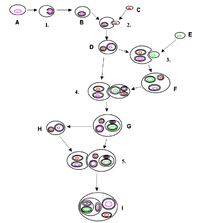
Photo from wikipedia
Wigglesworthia glossinidia is an obligate, maternally transmitted endosymbiont of tsetse flies. The ancient association between these two organisms accounts for many of their unique physiological adaptations. Similar to other obligate… Click to show full abstract
Wigglesworthia glossinidia is an obligate, maternally transmitted endosymbiont of tsetse flies. The ancient association between these two organisms accounts for many of their unique physiological adaptations. Similar to other obligate mutualists, Wigglesworthia's genome is dramatically reduced in size, yet it has retained the capacity to produce many B-vitamins that are found at inadequate quantities in the fly's vertebrate blood-specific diet. These Wigglesworthia-derived B-vitamins play essential nutritional roles to maintain tsetse's physiological homeostasis as well as that of other members of the fly's microbiota. In addition to its nutritional role, Wigglesworthia contributes towards the development of tsetse's immune system during the larval period. Tsetse produce amidases that degrade symbiotic peptidoglycans and prevent activation of antimicrobial responses that can damage Wigglesworthia. These amidases in turn exhibit antiparasitic activity and decrease tsetse's ability to be colonized with parasitic trypanosomes, which reduce host fitness. Thus, the Wigglesworthia symbiosis represents a fine-tuned association in which both partners actively contribute towards achieving optimal fitness outcomes.
Journal Title: Microbiology
Year Published: 2022
Link to full text (if available)
Share on Social Media: Sign Up to like & get
recommendations!